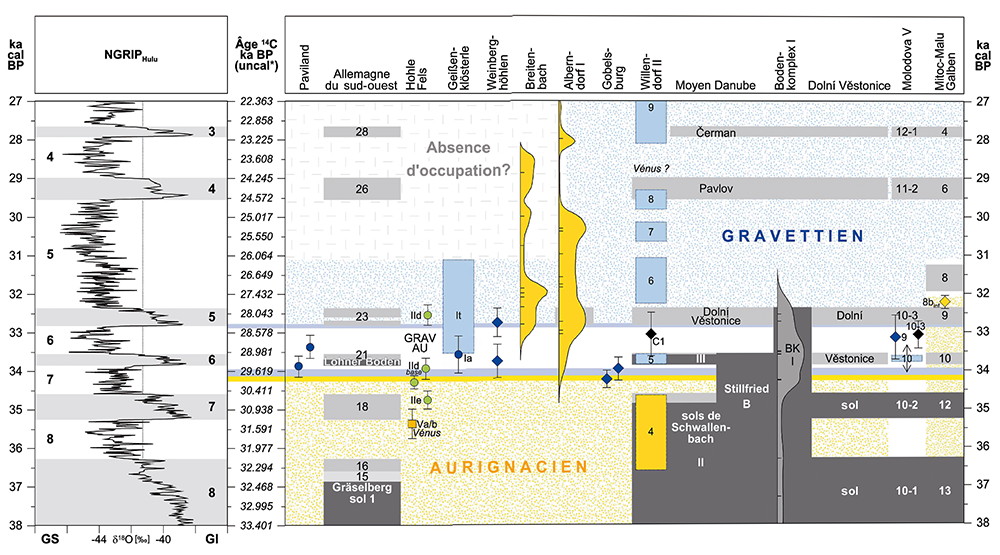Back to Don's Maps
 Back to Archaeological Sites
Back to Archaeological Sites
Back to Venus figures from the Stone Age
Breitenbach Venus
Fragments of a 34 000 year old ivory Venus discovered in Saxony-Anhalt
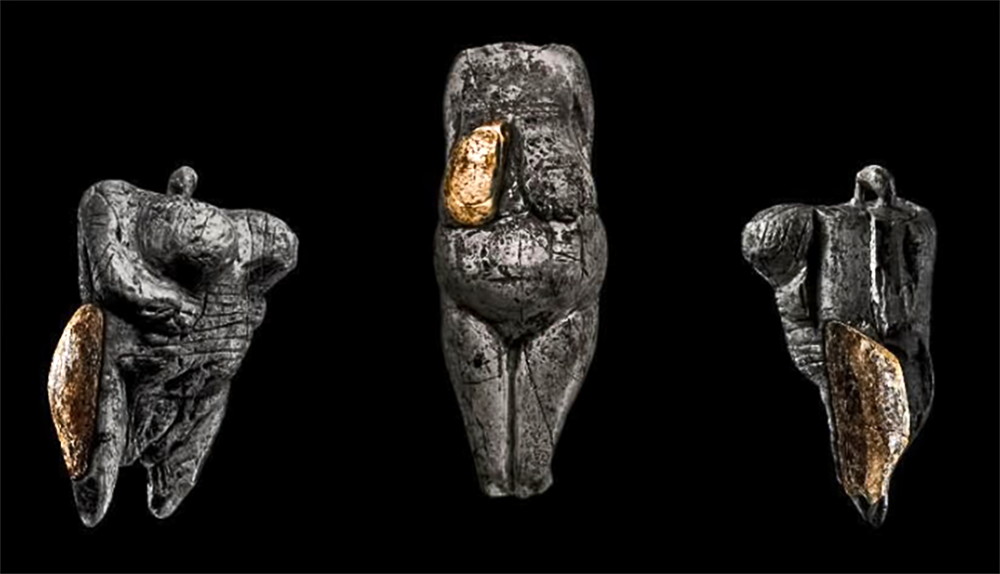
Three small ivory fragments from a 34 000 year old ivory Venus discovered in Saxony-Anhalt
Photo: © J. Lipták / MAE RAS, through MONREPOS in Neuwied, an institution of the Römisch-Germanisches Zentralmuseum Mainz (RGZM)
Source: https://archaeologynewsnetwork.blogspot.com.au/2017/11/34000-year-old-ivory-venus-discovered.html#AfEpTqgSbDJVuYPj.97
The extensive open-air settlement site of Breitenbach on a spur above the Aga River has been known since the 1920s and represents one of the northernmost sites of the Aurignacian (ca. 40 000 - 33 500 BP), the earliest phase of the Upper Palaeolithic in Europe.Text above adapted from: https://archaeologynewsnetwork.blogspot.com/2017/11/34000-year-old-ivory-venus-discovered.html#7bDmTzZBY1Yl9AWz.99
The 34 000 year old Breitenbach site has already produced spectacular results in the past. Five years ago, tiny beads from the world's oldest ivory workshop with clearly defined work areas were found there. Not only 'fresh' but also much older fossil mammoth ivory was processed in this workshop, which was obviously washed and deposited in Breitenbach well over 200 000 years ago.
In 2012 several ivory fragments were discovered, which were recently recognised by excavation leader Dr. Olaf Jöris and his team as fragments of a 'Venus' figure made of ivory.
These three small ivory fragments from Breitenbach, which are only between 14 mm and 18 mm in size seem to be very inconspicuous at first glance, but have been carefully worked and polished on the surface, and can be fitted effortlessly into completely preserved figures such as those known from the 'Hohle Fels' in the Swabian Alb.
Until now, sculptures made in the Aurignacian period were only known from caves in the Swabian Alb, which is one of the reasons why they were included in this year's UNESCO World Heritage List. Only with the following 'Gravettien' phase (approx. 33 500 - 23 500 BP) can figurative sculptures be found throughout Eurasia.
( note that this age, 34 000 BP, is right on the edge of the Aurignacian-Gravettian divide. Some might argue that this find is from the very early Gravettian. In addition, the fragment of the breast has been compared in the main photograph to that of the Kostenki 1, Venus figure number 4, which is 25 000 BP or younger - Don )
The finds at Breitenbach show that figurines in the Aurignacian form part of a tradition that originated in Central Europe and were not limited to southern Germany alone. In addition, they show that this idea did not spread until the transition from the Aurignacian to the 'Gravettien'.
Breitenbach is thus at the turning point of a supra-regional cultural upheaval, which can probably be understood as a change in the world views of the time and in social interaction.
Open air finds from this early phase of the late Palaeolithic period are relatively rarely preserved. Most of the finds from this period originate from caves, which however are often transformed by later use.
At the end of the Aurignacian phase, Breitenbach was situated on the northernmost edge of the inhabited world due to pronounced glaciation.
A little more than 40 000 years ago, modern humans, Homo sapiens, first settled Europe. They encountered populations of Neanderthals, which they gradually replaced, although there was also limited genetic exchange between the two.
With the appearance of modern man, jewellery and art can be found in Europe for the first time.
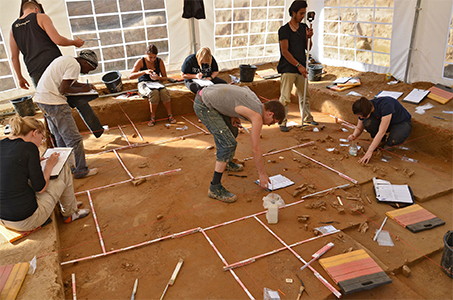
Documentation of the finds at the ivory workshop at Breitenbach by an international student team.
Photo: Olaf Jöris, MONREPOS
Permission: Creative Commons Attribution-Share Alike 3.0 Unported license.
Source: Wikipedia
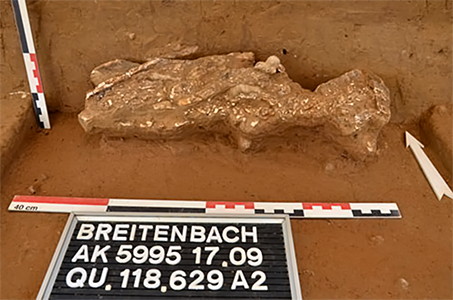
Concentration of ivory splinters that characterise the processing waste of the ivory workshop.
Photo: Olaf Jöris, MONREPOS
Permission: Creative Commons Attribution-Share Alike 3.0 Unported license.
Source: Wikipedia
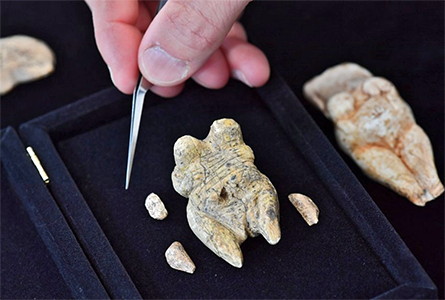
Fragments of the new venus, with the Venus of Hohle Fels for comparison.
Photo: Landesamt für Denkmalpflege und Archäologie Sachsen-Anhalt
Source: http://www.spiegel.de/fotostrecke/archaeologie-sexsymbole-der-steinzeit-fotostrecke-155580-3.html
The archaeological site near the village Breitenbach in Burgenlandkreis ( Saxony-Anhalt ) is an important representative of the Aurignacian. The open air site was visited and used by anatomical modern humans more than 30 000 years ago. With an area of about 10 000 square metres, Breitenbach is the largest outdoor site of the Aurignacien in western Eurasia. Sites of such size are otherwise known only from the GravettienText above: Wikipedia
During excavations in 2012, a mammoth ivory workshop was discovered, the oldest in the world. This area differs fundamentally from the rest of the site areas and thus provides one of the earliest references to modern human spatial behaviour.
The size and assumed function of the site is unusual for the early Upper Paleolithic. The total area is estimated to be 10,000 square meters, based on the results of geoarchaeological surveys. Sites of such sizes are otherwise known only from the Gravettien. Because of its size, it can be designated as a 'base camp'.
Chronostratigraphy of the transition from the Aurignacian (orange) to the Gravettian (blue) north of the Alps in the time period between 38 000 and 27 000 cal BP, based on detailed climatic records of the Greenland NGRIP.
A pedostratigraphic correlation with the continental paleosoils serves as a reference (right: in gray). The series of 14C dates available for Breitenbach and Alberndorf I have been calibrated by means of CalPal-2007 software.
Calibrated 14C dates: Lozenges for charcoal, circles for bone.
Venus from Hohle Fels to indicate calibrated age based on the mean value of three samples found in the immediate vicinity of the statuette.
Molodova V: Calibrated age based on the mean value of diverse 14C dates.
PK I: The horizontal coloured lines represent respectively the last manifestations of Aurignacian in secured stratigraphic context (orange line: 30 000 - 29 800 14C BP), as well as first evidences of the beginnings of Gravettian (blue line: between 29 800 - 29 500 and 28 500 - 28 400 ka 14C BP) in Europe.
* Reference scale of non calibrated 14C dates with intervals corresponding to 500 years cal BP (based on the calibration curve CalPal-2007Hulu) calculated with a standard deviation of ± 1 BP.
Photo and text: Moreau and Jöris (2009)
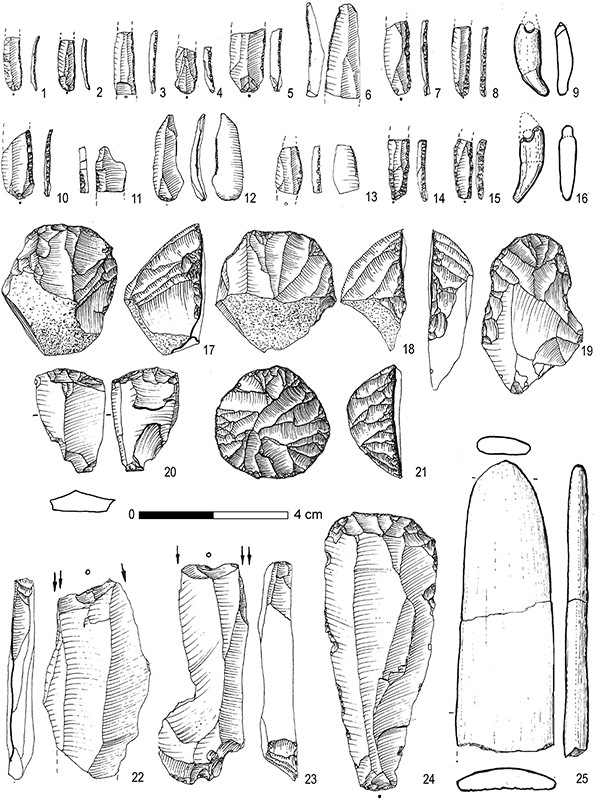
Breitenbach A lithic industry.
1 to 6 and 11: Bladelets with unilateral marginal retouch
12 and 13: Dufour bladelets
7, 8, 10, 14 and 15: Backed bladelets
17, 18 and 21: Carinated scrapers
19: Nosed scraper
20: Splintered piece
22 and 23: Burins on truncation
24: End scraper with lateral retouch
9 and 16: Perforated fox canines
25: Smoother.
Photo and text: Hahn (1977)
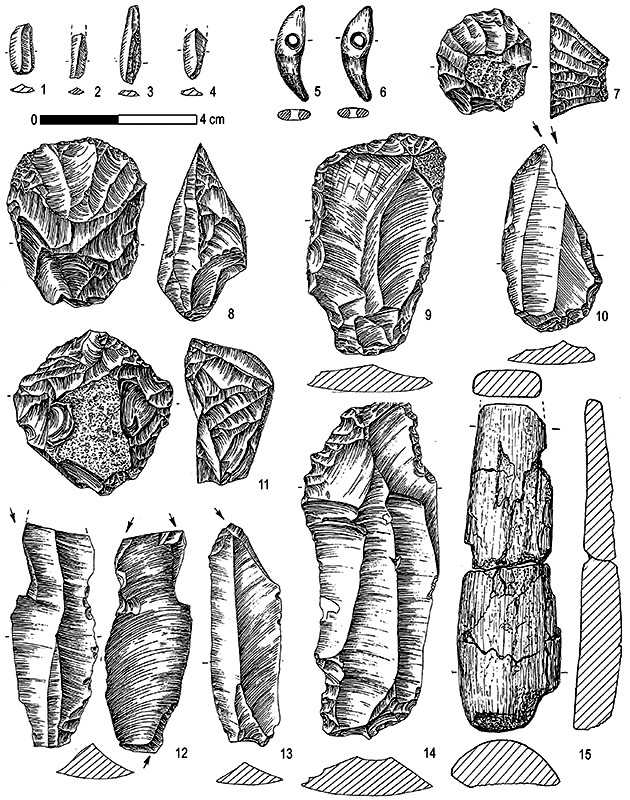
Breitenbach B lithic industry.
1 to 4: Bladelets with unilateral marginal retouch
7, 8 and 11: Carinated scrapers
9 and 14: Truncated blade with lateral retouch
10: Burin-End scraper
12: Burin on break
13: Burin on truncation
5 and 6: Perforated fox canines;
15: Bone point with rounded base (Mladec type ?)
Photo and text: Richter (1987)
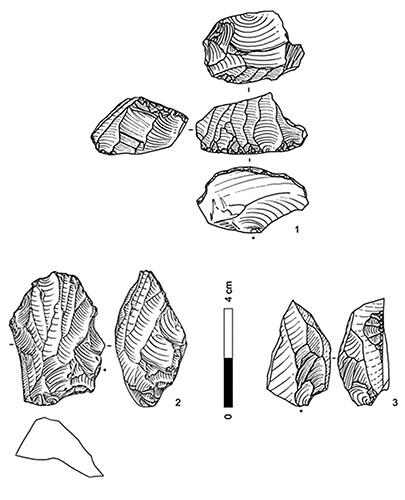
Tools from the Aurignacian of Breitenbach.
1: Carinated end scraper on core tablet.
2: Carinated end scraper on debitage surface preparation flake.
3: Abandoned preform of a carinated end scraper on debitage surface preparation flake
Drawings: (1, 3) L. Moreau, (2) G. Rutkowski
Photo: Moreau (2012)
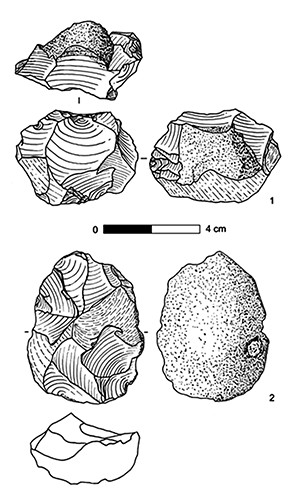
Tools from the Aurignacian of Breitenbach.
1: Irregular flake core on a thick core-trimming flake
2: Prismatic blade core recycled as flake core
Drawings: L. Moreau
Photo: Moreau (2012)
References
- Conard N., 2009: A female figurine from the basal Aurignacian deposits of Hohle Fels Cave in southwestern Germany. Nature, 2009; 459 (7244): 248 DOI: 10.1038/nature07995
- Cook, J., 2013: Ice Age art: arrival of the modern mind, The British Museum, 18 Feb 2013, ISBN-10: 0714123331, ISBN-13: 978-0714123332
- Hahn, J., 1977: Aurignacien. Das ältere Jungpaläolithkum in Mittelund Osteuropa, Cologne-Vienne, éd. Böhlau (Fundamenta Reihe A 9), 355 p
- Moreau, L., 2012: The Aurignacian of Breitenbach, status of flake production, Flakes not Blades, Wissenschaftliche Schriftendes Neanderthal Museums 5, Mettmann 2012
- Moreau, L., Jöris O., 2009: La fin de l’Aurignacien. Au sujet de la position chronologique de la station de plein air de Breitenbach dans le contexte du Paléolithique supérieur ancien en Europe centrale, Mémoire LVI de la Société préhistorique française, In : P. Bodu, Chehmana L., Klaric L., Mevel L., Soriano S., Teyssandier N. (eds.): Le Paléolithique supérieur ancien de l’Europe du Nord-ouest, Actes de la table-ronde de Sens (avril 2009), Mémoire de la SPF, p. 395-414.
- Richter, J., 1987: Jungpaläolithische Funde aus Breitenbach/Kr. Zeitz im Germanischen Nationalmuseum Nürnberg, Quartär, 37-38, p. 63-96.
Back to Don's Maps
 Back to Archaeological Sites
Back to Archaeological Sites
